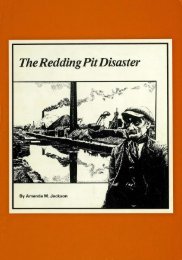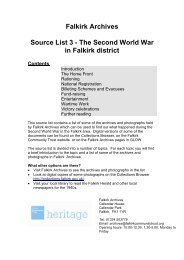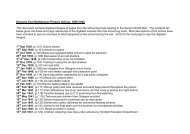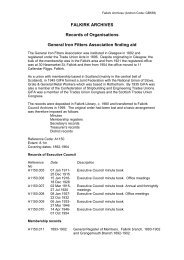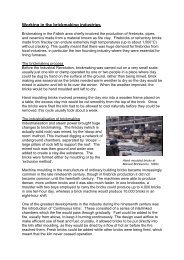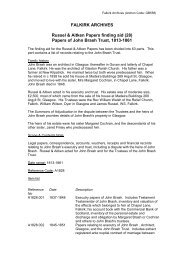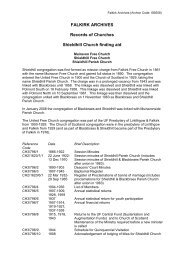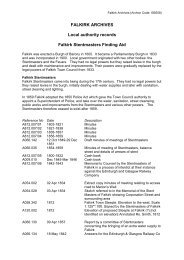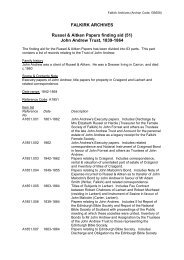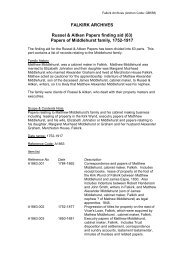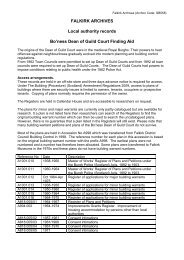Health & Housing source list - Falkirk Community Trust
Health & Housing source list - Falkirk Community Trust
Health & Housing source list - Falkirk Community Trust
Create successful ePaper yourself
Turn your PDF publications into a flip-book with our unique Google optimized e-Paper software.
Contents<br />
<strong>Falkirk</strong> Archives<br />
Source List 1- <strong>Health</strong> & <strong>Housing</strong><br />
<strong>Housing</strong><br />
Environmental health<br />
Hospitals and the medical professions<br />
Further reading<br />
This <strong>source</strong> <strong>list</strong> contains a <strong>list</strong> of some of the original archives and photographs<br />
held by <strong>Falkirk</strong> Archives which can be used for studying health and housing in<br />
the <strong>Falkirk</strong> area. Digital copies of some of the documents can be found on the<br />
Collections Browser or on the <strong>Falkirk</strong> Archives pages in GLOW.<br />
In 1830, public health was not considered to be the responsibility of government<br />
either at local or at national level. By 1930, local authorities had a statutory<br />
responsibility for constantly improving standards of housing and environmental<br />
health. Central government took responsibility for medical care and in 1948<br />
established the National <strong>Health</strong> Service. How did this happen?<br />
To help you find out, this <strong>source</strong> <strong>list</strong> contains notes on the general background to<br />
the three different aspects of public health, 1830-1930 and <strong>list</strong>s of original<br />
documents you can look at to find out about the way people in <strong>Falkirk</strong> and the<br />
surrounding areas dealt with health and housing.<br />
What other options are there?<br />
Visit <strong>Falkirk</strong> Archives to see the archives and photographs in the <strong>list</strong><br />
Search the on-line Collections Browser for photographs<br />
http://collections.falkirk.gov.uk/<br />
Visit your local library to read the <strong>Falkirk</strong> Herald and other local newspapers.<br />
.<br />
<strong>Falkirk</strong> Archives<br />
Callendar House<br />
Callendar Park<br />
<strong>Falkirk</strong>, FK1 1YR<br />
Tel: 01324 503779<br />
Email: archives@falkirkcommunitytrust.org<br />
Opening hours: 10.00-12.30, 1,30-5.00; Monday to<br />
Friday
1. <strong>Housing</strong><br />
<strong>Housing</strong> of the poor in the 1830s was overcrowded, insanitary and confined to<br />
small areas of the towns. <strong>Housing</strong> of the middle classes and wealthier people<br />
was slowly moving out of the inner urban areas and into the suburbs. In 1840,<br />
Professor W P Allison of Edinburgh University claimed that poverty was the root<br />
cause of ill health in his pamphlet "Observations on the Management of the Poor<br />
in Scotland and its effects on the health of the great towns", His pamphlet was a<br />
significant factor in the setting up of a Royal Commission of Inquiry into the Poor<br />
Law and the subsequent Poor Law (Scotland) Amendment Act of 1845. <strong>Housing</strong><br />
was one of the main issues which Allison identified.<br />
The main impetus for improving housing came from local magistrates and<br />
councillors in the large cities in an effort to improve public health and reduce<br />
disease. Glasgow led the way with the Glasgow Improvement Act, 1866, which<br />
permitted the Town Council to clear areas of the inner city, pull down the slums<br />
and sell the land for the building of new houses which were controlled by the<br />
planning authority, the Dean of Guild Court. In 1885 there was a Royal<br />
Commission of Inquiry into <strong>Housing</strong> and this was followed by a series of Acts of<br />
Parliament designed to improve the housing stock, destroy slums and re-house<br />
the inhabitants in better accommodation. The Acts put the responsibility for<br />
better housing on local authorities. They included the <strong>Housing</strong> of the Working<br />
Classes Acts of 1890 and 1914 and the <strong>Housing</strong> and Town Planning Act, 1909.<br />
<strong>Falkirk</strong> Archives holds plans showing housing developments under the <strong>Housing</strong><br />
of the Working Classes Acts, rent books of tenants, registers of local authority<br />
housing and registers of new housing under the Acts. The minutes of the Town<br />
Councils for the four burghs of Bo'ness, Grangemouth, Denny & Dunipace and<br />
<strong>Falkirk</strong> and the minutes of their respective housing committees are useful in<br />
tracing the response of the local authorities to their housing responsibilities.<br />
Ordnance Survey maps and other maps and plans can be used to see the<br />
changes in town boundaries and the growth of housing estates. There are also<br />
many relevant photographs which can be viewed on the Collections Browser
Bo’ness Burgh<br />
A005.003/01 20 May 1898-20<br />
Sep 1962<br />
""Fit for occupation"" notices under Burgh Police (Scotland) Act,<br />
1892<br />
A005.003/02 1898-1899 ""Fit for occupation"" notices under Burgh Police (Scotland) Act,<br />
1892<br />
A005.005 1923-1962 Notices to attend to defects in connection with discharge of roof<br />
water under Burgh Police (Scotland) Act 1892<br />
A005.001 1931-1956 Notices to occupiers to cleanse areas under Burgh police (Scotland<br />
) Act 1892. Contains counterfoils recording names, addresses and<br />
areas to be cleaned.<br />
A005.002 1898-1943 Notices to occupiers to cleanse areas under Burgh Police (Scotland)<br />
A005.004/01 20 Oct 1948-05<br />
Apr 1954<br />
A005.004/02 (Early 20th<br />
Century) {nd}<br />
A005.028/01 (Early 20th<br />
Century) {nd}<br />
Act 1892. Contains counterfoils and unused notices.<br />
Notice to occupiers on ""sweeping and washing of common stairs<br />
and passages"". Contains counterfoils and unused notices<br />
Unused notices to whitewash or paint walls and ceilings of common<br />
stairs and common passages<br />
Printed notices for display in rooms for letting regulating number of<br />
occupiers of room (unused)<br />
A440.01 27 Feb 1926 Burgh of <strong>Falkirk</strong> Sanitary Department registration ticket. Shows<br />
number of persons permitted to use specified room. Framed for<br />
display in room.
2. Environmental <strong>Health</strong><br />
In the 1830s, the activities we now refer to as environmental health did not really<br />
exist in most Scottish towns. There was little effort to collect refuse, there were<br />
open sewers and most people depended on wells for a water supply. Hot water<br />
had to be boiled on a fire and personal hygiene was poor. There was no attempt<br />
to keep the air clean, and smoke from factories and industrial workplaces<br />
combined with domestic fires to turn the air grey. There were few controls over<br />
the preparation of food: abattoirs, butchers, grocers and other food suppliers<br />
were not obliged to keep premises clean or ensure that the food was safe to eat.<br />
The middle classes recognised that poverty and ill-health were linked, and so<br />
they separated themselves from the disease-ridden working classes by building<br />
larger houses on the outskirts of the towns, creating suburbs. However, this did<br />
not remove the threat of death through disease, and so individual entrepreneurs<br />
and philanthropists lobbied central government to give local authorities the power<br />
to set standards and enforce them. People believed that diseases were spread<br />
through bad air rising from the polluted streets.<br />
Sanitation, as environmental health was called in the nineteenth century, was<br />
achieved primarily through the provision of water supplies and drainage and<br />
sewage systems. The City of Glasgow took a lead in this with the Loch Katrine<br />
water supplies in 1859. Towns also introduced other methods of cleanliness,<br />
such as sweeping streets, emptying middens, removing waste and disinfecting<br />
premises. Medical Officers of <strong>Health</strong> were appointed by Burghs and Counties to<br />
inspect business and domestic premises, dairies and abattoirs and to enforce<br />
standards of public hygiene and cleanliness.<br />
The authority to develop public health in this was granted to local authorities<br />
through a series of private and public Acts of Parliament. The main ones were<br />
the Nuisance Removal (Scotland) Act, 1856, the General Police and<br />
Improvement (Scotland) Act, 1862, the Sanitary Act, 1866 and the Local<br />
Government (Scotland) Act, 1894, as well as the various Public <strong>Health</strong> Acts and<br />
housing acts.<br />
<strong>Falkirk</strong> Archives holds copies of some of the private acts for <strong>Falkirk</strong> and<br />
Grangemouth. There are records which show the debates over drainage and<br />
sewerage in the nineteenth century, records, photographs and films relating to<br />
refuse disposal and to re-cycling schemes, and plans which show drainage and<br />
sewage systems. Important <strong>source</strong>s are the minutes of the Town Councils of the<br />
four burghs of <strong>Falkirk</strong>, Grangemouth, Bo'ness and Denny & Dunipace, and the<br />
Sanitary and Cleansing Committees of these Town Councils.
Refuse Collection<br />
A series of short films were made for <strong>Falkirk</strong> Town Council during the 1950s,<br />
mainly by the Burgh Sanitary Inspector, Mr Alexander C French. These show the<br />
testing of equipment for refuse collection and street cleaning and snow<br />
clearance, as well as the equipment in use. There are also short films showing<br />
smoke emissions from the local foundries.<br />
Reference<br />
No<br />
Date Description<br />
A778.025 (1950s-1960s) Video of films by Alexander C French of <strong>Falkirk</strong> parks, gala days, housing<br />
developments, royal visits road gritting and snow removal, duties of the<br />
sanitary inspector and refuse collection. Includes a film of Fairlie St Coup<br />
and rubber snow plough; film of Sanitary Inpector's duties including<br />
sewage,street pipes, River Carron, air pollution, steam engine, tannery,<br />
bakery, tinned foor, domestic water pipes; and film showing collection and<br />
disposal of kitchen and garden waste<br />
A935.001 (1950s-1960s) Video of films showing bin test, bins and bin issues, bin emptying at<br />
works. (Cuts from slow motion), bins being emptied with refuse lorry and<br />
workers, bin loaders at works (slow motion), refuse collection (rats &<br />
mice, Golf Course refuse collection, Glenfuir), Redbrae Coup, Stadium<br />
site and Fairly St Coup, refuse collection : side loader, Redbrae Tip,<br />
Refuse Disposal (Appears to be intended for longer film for public viewing.<br />
Begins with Scene 13 Take 1 made by Alexander C French ), Fairly St<br />
Coup and Burnbrae Old Folks Home, street washing experiment, back of<br />
Derwent Ave, horse shoe spraying under gully empties; street washing<br />
140 sprays side gully machine, street washing - lairgs old gully and new<br />
gully, smoke observations (J & A Towers, <strong>Falkirk</strong> iron Co, Carron Co,<br />
Aitkens, Grahamston Iron Co, Carron Co, Hendry St, Grahamston Iron Co<br />
cupolas, <strong>Falkirk</strong> Iron Co, J & A Towers) Redbrae Tip. <strong>Falkirk</strong> Snow<br />
Clearance (shows salting and sanding machines) <strong>Falkirk</strong> Town Council<br />
Films. "Snow clearing in <strong>Falkirk</strong>”. ( Shows the development and features<br />
of the <strong>Falkirk</strong> Rubber Snow Plough: a collection of shots taken during<br />
development, 1952-1963) "Development of a Bin Scheme" , and "Public<br />
Cleansing : Refuse Analysis" <strong>Falkirk</strong> Town Council film<br />
<strong>Falkirk</strong> Town Council took a series of photographs to record the machines and<br />
vehicles they used to clean the streets and collect household and business<br />
rubbish. Digital copies of these can be seen in the Collections Browser<br />
Reference<br />
No<br />
Date Description<br />
P15864 1936-1937 Horse-drawn Refuse Cart in Dorrator Rd, <strong>Falkirk</strong> Message on cart reads<br />
P22476 [1950s]<br />
"If your rates you would reduce, reduce the refuse you produce".<br />
<strong>Falkirk</strong> Town Council refuse vehicle in Cow Wynd. Also shows Woodside<br />
Home a working men's hostel, which was earlier <strong>Falkirk</strong> Poorhouse, later<br />
<strong>Falkirk</strong> Trades School<br />
P22477 [1950s] <strong>Falkirk</strong> Town Council refuse vehicle in Cochrane Street, <strong>Falkirk</strong><br />
P22483 1965 May 10 <strong>Falkirk</strong> Town Council refuse vehicle, showing compressor. On reverse is<br />
written "Ram moving in"<br />
P22484 1965 May 10 Bin emptying into <strong>Falkirk</strong> Town Council refuse vehicle<br />
P22488 [Mid 1960s] <strong>Falkirk</strong> Town Council refuse vehicle with workers loading bins for emptying<br />
P22489 [Mid 1960s] <strong>Falkirk</strong> Town Council refuse vehicle. Bins being emptied
Drainage and Sewage<br />
Local authorities were responsible for drainage and sewage.<br />
<strong>Falkirk</strong> drainage schemes<br />
Reference<br />
No<br />
Date Description<br />
A066.161 26 Jul 1852 Estimate submitted to Henry Salmon, Chairman of Sanitary Committee, by<br />
Nimmo & Harrison, Bo'ness, for drainage work in <strong>Falkirk</strong> High St and<br />
surrounding areas.<br />
A066.162 14 Jul 1852 Specification for the sewerage and causewaying of the High Street of <strong>Falkirk</strong><br />
as proposed to be done by the Committee appointed by the Subscribers to<br />
the Fund for that purpose (ie : <strong>Falkirk</strong> Sanitary Committee)<br />
A066.158 10 Oct 1877 Report of James Deas, Glasgow, on the sewage arrangements in <strong>Falkirk</strong><br />
Burgh with recommmendations for improvements. Critical of outfalls ""which<br />
I found in a more or less offensive state and I fear prejudicial to the health of<br />
those living or engaged in business in their vicinity"". Detailed report.<br />
A066.174 22 Oct 1877 Letter, James Deas, Clyde Navigation to John Russel, Provost of <strong>Falkirk</strong><br />
concerning estimate for sewage scheme<br />
A066.173 1878 Minute of meeting of <strong>Falkirk</strong> Police Commissioners Drainage Committee<br />
concerning refusal of some ratepayers to pay for drainage scheme<br />
A066.147 29 Nov 1878 Minutes of meeting on progress of drainage scheme for <strong>Falkirk</strong><br />
A066.149 29 Nov 1878 Draft minutes of meeting of <strong>Falkirk</strong> Police Commissioners as the local<br />
authority under the Public <strong>Health</strong> Act, 1867, concerning objections to the<br />
<strong>Falkirk</strong> drainage scheme<br />
A066.151 1878 Minutes of meeting concerning drainage and rates<br />
A066.175 28 Jan 1878 Report, Drainage Scheme Committee of the Police Commissioners,<br />
concerning work in progress<br />
A066.145 27 Apr 1878 Saturday <strong>Falkirk</strong> Herald and Linlithgow Journal. Contains articles on <strong>Falkirk</strong><br />
drainage scheme and advertisement for let of the customs<br />
A066.184 1878 List of proprietors who have commented on proposed drainage scheme<br />
066.156 14 Oct 1878 Letter, William Black, civil engineer and architect, <strong>Falkirk</strong> to Robert<br />
Henderson, (Clerk to Police Commissioners) with estimate for drainage<br />
scheme<br />
A066.157 21 Jun 1879 Letter, William Black, civil engineer and architect, <strong>Falkirk</strong> to Robert<br />
Henderson, (Clerk to Police Commissioners) concerning alterations to<br />
drainage scheme<br />
A066.146 1879 Contract between <strong>Falkirk</strong> Police Commissioners and J & A Reid, builders,<br />
relating to drainage improvements for <strong>Falkirk</strong><br />
A066.182 1879 Report to the Board of Supervision on the drainage of the Burgh of <strong>Falkirk</strong><br />
outlining necessary improvements.<br />
A066.155 09 Jun 1879 Letter, Board of Supervision for the Poor Law to Clerk to the <strong>Falkirk</strong> Police<br />
Commissioners concerning loan of £4,500 from the Publicc Works Loan<br />
Commissioners<br />
A066.181 06 Jun 1882 Letter, Local Government Board to <strong>Falkirk</strong> Town Clerk, concerning request<br />
from Police Commissioners for loan and requesting further details of<br />
drainage scheme<br />
A066.177 22 Jun 1882 Draft letter, Robert Henderson, Burgh Clerk, to the Local Government Board<br />
concerning expenses incurred in carrying out the burgh drainage scheme<br />
and request for loan to complete works<br />
A066.159 17 Nov 1882 Letter, Caledonian Railway Co Canal Dept to Robert Henderson, Town<br />
Clerk, concerning the line of the proposed sewer<br />
A066.180 29 Dec 1882 Letter, John Gibson, Camelon Iron Co, complaining of damage to goods<br />
caused by a culvert overflowing and flooding warehouse
Reference<br />
No<br />
Date Description<br />
A066.178 29 Dec 1882 Letter, John Aitken, Gartcows, to Robert Henderson, Clerk to Police<br />
Commissioners, claiming compensation for damage to boundary wall<br />
caused by the flooding of the town's reservoir.<br />
A066.179 27 Mar 1883 Letter, William Black, civil engineer, to Town Clerk, concerning details of<br />
proposed diversion of water course at <strong>Falkirk</strong> Upper Station [High Station]<br />
A066.150 14 Jun 1888 Extract minutes of meeting of <strong>Falkirk</strong> Sanitary Committee concerning the<br />
extension of drainage pipe to Parkfoot<br />
A066.113 20 Oct 1888 Record in appeal (to the Court of Session), the Feuars of <strong>Falkirk</strong> against the<br />
trustees for the Roman Catholic diocese of Edinburgh and St Andrews<br />
concerning drainage and sewerage through Callendar Riggs<br />
A066.148 1889 Report on the progress of <strong>Falkirk</strong> Drainage Works from the date of<br />
acceptance of Mr Gall's offer to 31 March 1889<br />
A066.171 Nov 1889 <strong>Falkirk</strong> drainage works. Report on work done for month ending 16th<br />
November 1889.<br />
A066.172 Nov 1889 <strong>Falkirk</strong> drainage works. Statement of work done on west section for weeks<br />
ending 22 June 1889 and 3 August 1889<br />
A066.164 23 Sep 1890 Plan showing line of proposed drain from Blinkbonny to Burnhead, <strong>Falkirk</strong>.<br />
A066.165 27 Feb 1890 Report on <strong>Falkirk</strong> Drainage Works as executed by Mr Alexander Gall,<br />
Contractor, Alloa, following inspection by James Strang and Sanitary<br />
Committee<br />
A066.176 1890 Report to sanitary committee, estimated cost of improved drainage<br />
proposals for the souther portion of <strong>Falkirk</strong> Burgh<br />
A066.183 1891 Report, William Neilson, Sanitary Inspector on Howgate drainage<br />
A066.153 23 Feb 1893 Report by Sanitary Inspector as to Drainage from Hospital. Relates to cost<br />
of proposed sewage improvements<br />
A066.143 01 May 1894 Sanitary Inspector : Report for March & April<br />
A066.144 1895 Sanitary Inspector: Report for January 1895<br />
A066.166 1901 Statement of Claim, Defence and Judgement in action of J Ambler & Sons<br />
Ltd against Bradford Corporation. Relates to increase of volume of water<br />
passing through streams under premises of J Ambler & Sons Ltd due to<br />
drainage schemes of Bradford Corporation<br />
A066.198 1909 List of drains to be indexed in drainage book.<br />
A066.200 1909 Draft measurement of slaughterhouse improvement. Schedule of quantities<br />
of various works at slaughterhouse and schedule of iron and engineering<br />
work of proposed alterations at slaughterhouse. Envelope annotated ""176""<br />
A066.209 1909 Draft calculation for Camelon main outfall from slaughterhouse. Envelope<br />
annotated ""168""<br />
A066.169 1911 Analysis of sewage contamination of River Carron and water analysis.<br />
(Pages torn from larger document)<br />
A066.170 1911 List of privies and ashpits in the districts of Larbert, Stenhousemuir, Carron<br />
and Laurieston, compiled for the promoters of the <strong>Falkirk</strong> Burgh Extension<br />
Order, 1911. Includes information about condition of privies and ashpits, and<br />
name of owners.<br />
A066.070 1929 <strong>Falkirk</strong> Burgh Order Confirmation Act 1929. Relates to <strong>Falkirk</strong> Burgh<br />
Extension<br />
A066.077 10 May 1929 <strong>Falkirk</strong> Burgh Confirmation Act, Relates to Burgh extension, drainage & c<br />
Grangemouth Drainage<br />
A007.012 (Circa 1950s) Articles on drainage and sanitation in<br />
Grangemouth<br />
Porteous Collection<br />
Bo’ness drainage schemes<br />
A818.002 1894-1900 Minute Book No 1. Bo'ness Burgh Local Authority. (Public <strong>Health</strong>)<br />
A005.051 Oct 1878 Report on proposed main sewer outfall at Bo'ness<br />
A010.239/01 19 Oct 1878 Plan of Bo'ness Sewerage containing details of manholes, sewers,<br />
pipe sections, tied door sectional plans. Drawing no 2, Plan no 0225<br />
General scale 1"":2ft<br />
A058.014 19 Oct 1878 General plan and section for Bo'ness sewerage. Drawing No 1. Plan
No 0224. Scale 1"":100ft<br />
A058.077 30 Mar 1881 Plan, Bo'ness Drainage Scheme. Showing existing drains and<br />
proposed new sewers. Sheet No.1. Scale 0.75"":100ft<br />
A058.056 1881 Plan, Bo'ness Drainage Scheme. Sections, details and elevations.<br />
Sheet No.2. Referred to in a report on the drainage of Bo'ness dated<br />
8th Apr 1881<br />
A058.057 (1881) {nd} Plan, Bo'ness Drainage Scheme. Sections and details. Sheet No.2.<br />
Scale 0.75"":100ft<br />
A058.063 09 Apr 1881 Plan of Bo'ness Burgh proposed system of Main Sewerage. Sheet<br />
No.1. Scale 1"":125ft<br />
A058.349 (1881) {nd} Diagram of Bo'ness Drains according to alterations plan. Sheet No.3.<br />
Diagram if referred to in the report on the Drainage of Bo'ness of 8th<br />
Apr 1881.<br />
A005.028/02 31 Aug 1882 Report on a scheme of drainage for the town of Bo'ness<br />
A058.018 (Circa 1903) Plan showing drainage system for Furnace Row and Snab, Bo'ness.<br />
Scale 1"":50ft<br />
A058.078/01 21 Nov 1949 Plan of Bo'ness Burgh West End Drainage. Proposed outfall at Snab.<br />
Showing the line of the sewer on Bo'ness Town Council property.<br />
Scale 1"":200ft<br />
A058.078/02 21 Nov 1949 Plan of Bo'ness Burgh West End Drainage. Proposed outfall at Snab.<br />
Showing the line of the sewer. Scale 1"":200ft<br />
A058.078/03 20 Dec 1949 Plan of Bo'ness Burgh West End Drainage. Showing amended line of<br />
sewer on the property of thee National Coal board at Kinneil Colliery.<br />
Scale 1"":200ft
Recycling<br />
There are a number of photographs which show recycling efforts in the 1940s<br />
and 1950s<br />
P22430 1940s Recycling advertising on Glasgow tram during the Second World War<br />
P22431 1940s Caravan with recycling advertising during Second World War<br />
P22432 1939-1945 Caravan with recycling advertising at Brockville refuse depot, <strong>Falkirk</strong><br />
P22433 1940s Shop window display about recycling from domestic refuse during<br />
Second World War<br />
P22436 1950s Bales of waste paper stockpiled in area at rear of Brockville<br />
separation and incineration plant.<br />
P22437 1950s Scrap metal at Brockville Refuse<br />
P22438 1940s Shop window display about recycling from domestic refuse during<br />
Second World War<br />
P22439 1951 Sep 25 Display about recycling from domestic refuse<br />
P22440 1951 Sep 25 Display about recycling from domestic refuse<br />
P22441 1951 Sep 25 Display about recycling from domestic refuse<br />
P22449 [Early 1950s] Refuse depot and workers on recycling drive, Brockville Dump<br />
P22450 [Early 1950s} Recycling drive in Camelon. Railway station in background<br />
P22451 [Early 1950s] Brockville refuse depot and workers during recycling drive<br />
Landfill and Disposal of Refuse<br />
P22498 1955 Landfill site at Easter Carmuirs. Handwritten on the reverse is "This<br />
shows the original ground surface and the concrete culvert taking the<br />
stream. The proximity of the houses is clearly shown" Site at Easter<br />
Carmuirs, due to be landfilled and then landscaped, showing the<br />
culvert on the burn The site was landscaped and turned into playing<br />
fields off Mariner Avenue<br />
A005.023/06 27 Sep 1893 Notice issued by Bo’ness Port Authority on discharge of water by<br />
vessels arriving from cholera infected ports
Street Cleansing<br />
P22456 Mar 1960 Street sweeping by machine in Cow Wynd. Looking towards town<br />
centre, Comely Park School railings on left<br />
P22457 Mar 1960 Street sweeping by machine in Woodside Terrace, <strong>Falkirk</strong><br />
P22458 Mar 1960 Street sweeping by machine in Cow Wynd. Looking towards power<br />
station<br />
P22459 Mar 1960 Street sweeping by machine in Woodside Terrace, <strong>Falkirk</strong><br />
P22460 [1950s] Drain cleaning, corner of Hodge St & Cockburn St, <strong>Falkirk</strong> . Same<br />
lorry is seen in p10912, p22461, p22462<br />
P22461 [1950s] Hosing down Westburn Avenue, <strong>Falkirk</strong><br />
P22462 [1950s] Street washing. Two men washing down <strong>Falkirk</strong> street Same lorry is<br />
seen in p10912, p22460, p22461 On reverse is written “<strong>Falkirk</strong>’s new<br />
Squeegee”<br />
P22465 [1950s] Workmen washing down Camelon Rd<br />
P22466 [1950s] Workmen washing down <strong>Falkirk</strong> street<br />
P22491 [1960s] <strong>Falkirk</strong> Town Council suction machine. Drain cleaner<br />
P22497 [1940s] Road sweeping vehicle
3. Hospitals and the medical professions<br />
In the 1830s, there were very few hospitals. The ones which existed were built<br />
with charitable and private funds and bequests, usually through the work of a few<br />
doctors and philanthropists. During the nineteenth century, large teaching<br />
hospitals, known as infirmaries developed in Glasgow and Edinburgh, while<br />
smaller towns built cottage hospitals and fever hospitals. The fever hospitals<br />
were intended to cope with the regular outbreaks of cholera, typhus and other<br />
infectious diseases which resulted in a very high mortality rate. Often fever<br />
hospitals were built in conjunction with poor houses under the Poor Law<br />
(Scotland) Amendment Act of 1845.<br />
Between 1856 and 1911 there were a series of Public <strong>Health</strong> Acts which aimed<br />
at improving general health and controlling the spread of diseases. These<br />
included the Scotch Vaccination Act, 1863, which made vaccination against<br />
infectious diseases compulsory; the Infectious Diseases (Notification) Act, 1890<br />
and the Public <strong>Health</strong> (Scotland) Act, 1890. In 1909 the government introduced<br />
the medical inspection of schoolchildren.<br />
Until 1911 the main responsibility for hospitals and medical facilities was tackled<br />
at the local level and by local hospitals. In 1911 the National Insurance Act<br />
provided for insurance against sickness for workers and from then on the trend<br />
was for central government to take more control of the provision of health<br />
services.<br />
The medical professionals in the 1830s were all doctors and surgeons, most of<br />
whom in Scotland were trained by Glasgow and Edinburgh Universities and by<br />
the large teaching hospitals. Nursing was not considered to be a profession until<br />
the work of Florence Nightingale in the Crimea in the 1850s and the creation of<br />
training schools for nurses in Scotland in the 1880s.<br />
Most of the local records for hospitals and health services are held by the Forth<br />
Valley <strong>Health</strong> Board or by the National Archives of Scotland. <strong>Falkirk</strong> Archives<br />
has plans and photographs of some local fever hospitals and infectious diseases<br />
hospitals. There are also some records relating to the prevention of cholera
Preventing disease<br />
Hospitals and health services were used to prevent the spread of diseases as<br />
well as to care for people who were ill. Separate hospitals were built to take<br />
patients with infectious diseases in order to isolate them from the general<br />
population. There were strict rules about visitors. Often, hospitals limited the<br />
number of visitors and did not allow visitors into the ward but instead required<br />
them to stand behind a barrier a certain distance away from the patient. There<br />
were also strict rules about disinfecting clothes and other possessions.<br />
A174.022 1907 Rules for the management and regulation of infections diseases and<br />
smallpox hospitals in Bo'ness issued by Bo’ness Town Clerk.<br />
A1004.001 1928 Card issued to patients at <strong>Falkirk</strong> Infectious Diseases Hospital for use<br />
as admission card for visitors<br />
Paying for health<br />
Doctors and health care had to be paid for until the National <strong>Health</strong> Service was<br />
set up in 1948. There are a few documents in the Archives which show how<br />
much it cost to call in a doctor.<br />
Reference<br />
No<br />
Date Description<br />
A002.031 19 Jul 1808 Letter, James Burns, Parish of Craig to John Burns, <strong>Falkirk</strong>, following the<br />
death of John's son. Mentions preaching on the subject of children and<br />
disease<br />
A558.19 Jan 1907 Invoice & receipt from J. Harcourt Laurie, (doctor) "for professional<br />
attendance" to Louden family.<br />
A985.006 17 Sep 1936 Invoice to Mrs Christina Mackenzie for doctor's fees for attendance at birth<br />
of Iain MacKenzie (from MacKenzie Family Papers)<br />
A258.29/02 1939 Receipt, <strong>Falkirk</strong> and District Royal Infirmary, Sharp family<br />
A424.01/03 1948 National <strong>Health</strong> Service medical card of Margaret MacDonald, Carronflats<br />
Rd, Grangemouth<br />
A424.01/04 1946 Medical card of Robert M MacDonald, Carronflats Rd, Grangemouth<br />
Fundraising<br />
Until the National <strong>Health</strong> Service was introduced, most hospitals were built with<br />
funds raised by the local community. Some early hospitals were built by rates<br />
levied by the parochial boards under the Poor Law of 1845.<br />
Reference<br />
No<br />
Date Description<br />
A510.069 23 Dec 1904 Programme: Caledonian Railway Larbert Ambulance Corps twenty-second<br />
annual concert and assembly in Dobbie Hall, Larbert<br />
A510.070 01 Mar 1907 Programme: Caledonian Railway Ambulance Brigade (Larbert Corps)<br />
twenty-fourth annual concert and assembly in Dobbie Hall, Larbert<br />
A681.001 1925 "Callendar House, <strong>Falkirk</strong>. The opening of an historic mansion in the cause<br />
of charity" Contains description of house and furnishings. Printed to support<br />
<strong>Falkirk</strong> and District Infirmary. (See also A412.01 for photocopy)<br />
A233.012 11 Feb 1921 Photocopy of programme for recital by Fred Johnston and Miss F C Smillie<br />
in Bonnybridge Public Hall, in aid of <strong>Falkirk</strong> & District Infirmary Fund<br />
A609.001 (Nov 1939) Notice of appeal for funds for Slammanan, Limerigg & Avonbridge Nursing<br />
Association
Local Hospitals<br />
The earliest hospitals in the local area were built by parochial boards as<br />
poorhouses under the 1845 Poor Law. These housed people with no means of<br />
support, many of whom were disabled or diseased and so unable to work. Later,<br />
fever hospitals were built to isolate patients with infectious diseases, such as<br />
smallpox and measles.<br />
Articles and souvenirs on local hospitals<br />
Reference No Date Description<br />
A302.01 "Bellsdyke Hospital: A Short History" Written as part of a Manpower<br />
Services Commission project by R W Penn<br />
A240.023 11 May 1974 Photocopy of newspaper article ""<strong>Falkirk</strong> Infirmary. A look back to a local<br />
institution in the early 1920s"" by George Cruickshank<br />
A1099.003 1982 ""The <strong>Community</strong> that became one. A record of Provost John Docherty's<br />
Hospital Appeal Fund, 1981-1982"" by Alex Howson.<br />
A937.001 1901-1903 Photocopy ('The Passing Hour: The Magazine And Chronicle Of The<br />
Stirling District Asylum, Larbert'. Vols I,II,III - 1901, 1902, 1903. Contains<br />
articles written by and for patients and staff at Stirling District Asylum and<br />
photographs of the hospital. (see P24969 - P24980)<br />
A323.001/01 18 Jan 1932 Souvenir booklet for official opening of the new [<strong>Falkirk</strong>] infirmary by Prince<br />
George<br />
Running the hospitals<br />
Reference No Date Description<br />
A076.018 1945 Annual report, Denny and Dunipace Cottage Hospital<br />
A980.006 Apr 1898 Ninth annual report by the managers of the <strong>Falkirk</strong> Cottage Hospital<br />
A066.117 1907-1908 Proceedings (typescript) at a public inquiry into allegations of maladministration<br />
at the Infectious Diseases Hospital, <strong>Falkirk</strong>.<br />
A066.153 23 Feb 1893 Report by Sanitary Inspector as to Drainage from Hospital. Relates to cost<br />
of proposed sewage improvements<br />
Training the staff<br />
Reference No Date Description<br />
A319.004 1940-1944 Nursing Certificate of Helen L Fairweather from <strong>Falkirk</strong> & District Royal<br />
Infirmary<br />
A469.01 1894 ""The ambulance pupil's vade-mecum. Notes on First Aid"" by J F<br />
Sutherland<br />
A469.02 1936 Newscuttings relating to First Aid competitions and presentations<br />
A770.001 20 Dec 1942 St Andrew's Ambulance Association first aid certificate issued to Mrs Janie<br />
Macfarlane<br />
A736.005 23 Oct 1939 British Red Cross Society First Aid Certificate awarded to Flora<br />
MacDonald<br />
A736.007 25 Apr 1940 British Red Cross Society Home Nursing Certificate awarded to Flora<br />
MacDonald<br />
A736.020 1941 British Red Cross Society, Scottish Branch. Certificate of enrolment and<br />
permit to wear uniform issued to Ann MacDonald, Stirling Detachment 44
Further reading<br />
Sydney & Olive Checkland Industry and Ethos. Scotland 1832-1914 (1984) pp<br />
103-111<br />
T C Smout A Century of the Scottish people, 1830-1950 (1986) Ch. 2 The<br />
Tenement City<br />
Enid Gauldie Cruel Habitations. A History of Working Class <strong>Housing</strong>, 1780-1918<br />
(1974)<br />
Douglas Niven The Development of <strong>Housing</strong> in Scotland (1979) pp21-31<br />
Gordon McLachlan (ed.) Improving the Common Weal (1987) pp9-21 and pp<br />
58-59<br />
Local newspapers should also be consulted<br />
The <strong>Falkirk</strong> Herald available on microfilm from 1845-present<br />
Grangemouth Advertiser<br />
Bo’ness Journal<br />
Other printed <strong>source</strong>s<br />
B J Elliot (ed) Historical Sources For Central Scotland No 6. <strong>Housing</strong>, <strong>Health</strong><br />
and Welfare Central Regional Council, Stirling, 1982<br />
Edwin Chadwick Report On The Sanitary Condition Of The Labouring<br />
Population Of Great Britain, 1842<br />
Reprinted 1965 by Edinburgh University Press, M W Flinn (ed)<br />
Public <strong>Health</strong> in 19th Century Glasgow Strathclyde Regional Museum Education<br />
Service, Glasgow, 1996<br />
Fever in 19th Century Scotland Strathclyde Regional Museums Education<br />
Service, Glasgow,1996





